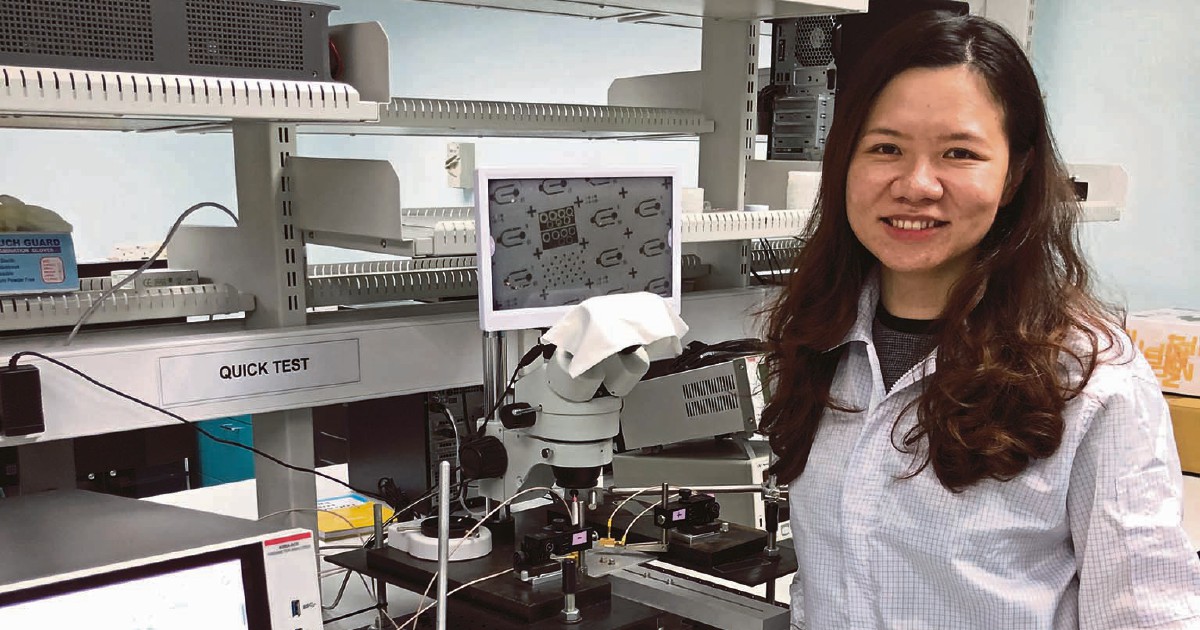
Smartphones, computers and flat-screen televisions are just among a few devices that use light-emitting diodes (LED) to boost screen brightness and clarity.
LED is a light source made of semiconductor material that causes electroluminescence, and these devices emit strong blue light.
Although LED is energy-efficient, overexposure to blue light, which is at the high-energy end of the visible light spectrum, is believed to be bad for a person’s vision and may interfere with body function.
The two factors that contribute to the issue are the proximity between a person’s eyes and the device’s screen, as well as the length of time spent staring at it.
To provide a better alternative, Dr Lim Way Foong has embarked on a study at Universiti Sains Malaysia’s (USM) Institute of Nano Optoelectronics Research and Technology to develop violet LED (VioLED), which has been marketed as a “healthier” light emission.
The USM senior lecturer was selected as one of L’Oreal-United Nations Educational, Scientific and Cultural Organisation Fellowship For Women in Science award winners recently in recognition of her research. She received RM30,000 to fund the project.
Lim said VioLED is also a semiconductor that emited violet light, which is at the highest end of the visible light range, just before the ultraviolet spectrum.
“The difference between violet and blue light is the wavelength. Violet LED light has shorter wavelength that spans from 380 to 420 nanometres, while blue LED light is beyond 420 nanometres
and terminates at approximately 500 nanometres.
“A retinal cell called ‘ipRGCs’, which stands for intrinsically-photosensitive retinal ganglion cells, is highly sensitive to blue light, particularly in the 450 to 480 nanometre wavelength.
“The ipRGCs transmit signals to the brain that control the body’s circadian rhythm, affecting melatonin production, which is a hormone that regulates the sleep-wake cycle.
“During the day, blue light does not bring much impact on humans because it keeps
us alert. However, its exposure in the evening and night will disrupt a person’s biological clock and activate the circadian cycle’s ‘wake-state’.
“This is because our brain will interpret the environment as day time when a high amount of blue light is received by the eyes. This makes it difficult to fall asleep even though we may be physically tired.”
Lim said sleeplessness during the night might negatively affect health.
“When people do not get enough sleep, their level of alertness will be affected during the day. In the long run, they will become easily irritated and emotional.”
She said the disruption of sleep quality would adversely affect the body’s attempt to detoxify itself.
“When we are sleeping, the organs will process and filter out toxins from the body. Each organ has an optimal time to reach its highest efficiency in detoxing the body. If we do not have good sleep or if the circadian rhythm is interrupted, some organs may not have sufficient time to filter out the toxins.
“This may lead to health issues, such as high blood pressure, diabetes, liver disease and colon cancer,” Lim said.
She added that spending too much time looking at the screens of electronic devices has increased the exposure of blue light on our eyes.
“It is hard to change our lifestyle unless we are willing to compromise by reducing the use of electronic gadgets in the evening.”
She said the impact of VioLED light on the body’s melatonin production was minimal compared with blue light.
This, Lim said, would lead to better sleep.
“However, it remains unknown as to which violet light wavelength is deemed suitable for human eyes. Currently, I’m studying the material composition of VioLED. We need to formulate a recipe for LEDs to emit violet light,” she said.
A personal experience had inspired Lim to pursue her research. During her first year of studying for her bachelor’s degree, her father’s right eye was infected by parasites.
“He was suffering from itchiness and
tears kept streaming from the eye. I asked a doctor on the cause of the infection, but I could not get a specific answer. The only way to treat his condition was to remove the eyeball.
“Since I am not in the medical field of study, I couldn’t contribute much. Therefore, I hope to help other people to take care of their eyes with my VioLED research, she said.
After completing her PhD in electronic materials, she became interested in 2014 Nobel laureate Professor Dr Shuki Nakamura’s blue LED invention.
Later, she joined Professor Dr Zainuriah Hassan’s team at Universiti Sains Malaysia to do research in LED light technology.
“Since I was new in the LED research field that time, I had to start with something fundamental. I spent two years experimenting and improving the base material for LED.The more I read, the more I discovered
the visual and non-visual impact of light,” she said.
Before starting her research on VioLED, Lim was working at ITRAMAS Corporation Sdn Bhd, an engineering company.
There, she was assigned to its research and development department.
It was a place that nurtured her vision to become a woman scientist, who was capable of conducting and managing research that brought positive impact to society.
“Science is about innovation and it is a matter of connecting the dots,” she said, adding that she hoped her research on VioLED would bear fruit next year.
2019-11-13 06:20:00Z
https://www.nst.com.my/education/2019/11/538156/scientist-hopes-aid-society-violed
CAIiEGGnCw4B9hETLEGJMrYkyToqGQgEKhAIACoHCAow9sveCjC0m9YBMPDtoQM
Bagikan Berita Ini














0 Response to "Scientist hopes to aid society with VioLED - New Straits Times"
Post a Comment